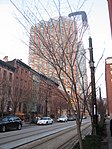The Museum of Russian Art (MoRA) is a museum in Jersey City, New Jersey dedicated to exhibiting Russian art, particularly Soviet Nonconformist Art. It was established in 1980 as CASE Museum of Contemporary Russian Art (the name including the abbreviation for the Committee for the Absorption of Soviet Emigres.) The museum's historic brownstone building in Paulus Hook underwent renovation and re-opened in 2010.The museum's mission statement as written in its request for proposals reads:
The Museum of Russian Art in Jersey City (MORA) is dedicated to being a preeminent cultural institution in its field, a major full-service art museum focusing upon the collection, preservation, documentation and exhibition of challenging and important artworks.
MORA is a space devoted to developing cultural exchange between different national diasporas in the US, and between the US and other countries. Emerging and established artists, both local and international, come together in both small and large scale exhibitions that center on the practice and creation of socially significant and innovative art. MORA is specifically interested in cultural programs of unity between nations, along with academic discourse and debate and how these are expressed and promoted by art and culture in general. MORA focuses on projects that show the cultural exchange, collaboration, and dialogue between different communities in the lives of artists-immigrants of any national descent, and within a greater pluralistic American community and nation, and any nation on the way towards establishing universal human values of culture in the cooperative world community.
The Museum's special focus is upon Russian art and culture, especially art and culture of the twentieth and twenty-first centuries, from the colossal achievements of the great Russian Avant-Garde (Kandinsky, Malevich and others) through the fascinating era of Nonconformist (or Unofficial) Art of the period between the late 1950s and the 1980s and up to the most recent developments in contemporary living artistic and cultural life. Russian art is broadly construed, including all art that can be associated with Russian culture – art belonging to the cultural life of Russia; art produced by Russians, Russian-speakers, and artists of Russian extraction, back- ground or heritage; art that is itself concerned with Russian language, history and culture – all this is within MoRA's purview.










